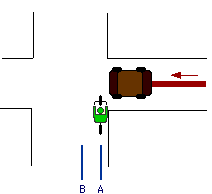Safety: How Not to Get Hit by a Car
 This is the most common way to get hit (or almost get hit). A car is pulling out of a side street, parking lot, or driveway on the right. Notice that there are two possible kinds of collisions here: Either you’re in front of the car and the car hits you; or the car pulls out in front of you, and you slam into it.
This is the most common way to get hit (or almost get hit). A car is pulling out of a side street, parking lot, or driveway on the right. Notice that there are two possible kinds of collisions here: Either you’re in front of the car and the car hits you; or the car pulls out in front of you, and you slam into it.
How to avoid this collision:
1. Get a headlight. If you’re riding at night, you absolutely need to use a front headlight. It’s required by law, anyway. Even for daytime riding, a bright white light with a flashing mode can make you more visible to motorists who might otherwise right cross you. Look for the new LED headlights which last ten times as long on a set of batteries as old-style lights. And headlamps (mounted on your head or helmet) are the best, because then you can look directly at the driver to make sure they see your light.
2. Wave. If you can’t make eye contact with the driver, wave your arm. It’s easier for them to see your arm going left and right than it is for them to see a bicycle coming straight towards them. You could also use a loud horn (like the AirZound) to get drivers’ attention. If it looks like the driver is about to pull out without seeing you, yell “Hey!” You may feel awkward waving or yelling, but it’s better to be embarrassed than to get hit. Incidentally, many countries require bells on bicycles, but the U.S. doesn’t.
3. Slow down. If you can’t make eye contact with the driver (especially at night), slow down so much that you’re able to completely stop if you have to. Sure, it’s inconvenient, but it beats getting hit. Doing this has saved too many lives to count.
4. Ride further left. You’re probably used to riding in the “A” line in the picture, very close to the curb, because you’re worried about being hit from behind. But look at the car. When that driver is looking down the road for traffic, he’s not looking in the bike lane or the area closest to the curb; he’s looking in the middle of the lane, for other cars. The farther left you are (such as in “B”), the more likely the driver will see you. There’s an added bonus here: if the motorist doesn’t see you and starts pulling out, you may be able to go even farther left, or may be able to speed up and get out of the way before impact, or easily roll onto their hood as they slam on their brakes. In short, it gives you some options. Because if you stay all the way to the right and they pull out, your only option may be to run right into the driver’s side door.
You might worry that moving left makes you more vulnerable to cars coming from behind. But the stats say you’re far more likely to get hit by a car at an intersection ahead of you that can’t see you, than from a car behind you which can see you clearly. So, while both positions have risk, you generally reduce your risk by riding a little farther left. Your actual lane position depends on road conditions. On fast roadways with few cross streets (and thus less chances to get hit at intersections), you’ll ride farther to the right. On slow roads with many cross streets, you’ll ride farther left.
Safety Committee, excerpted from BicycleSafe.com
